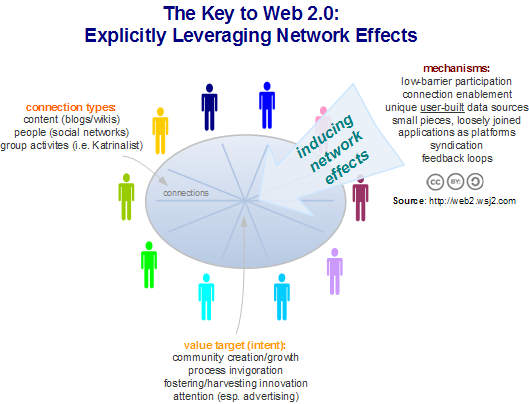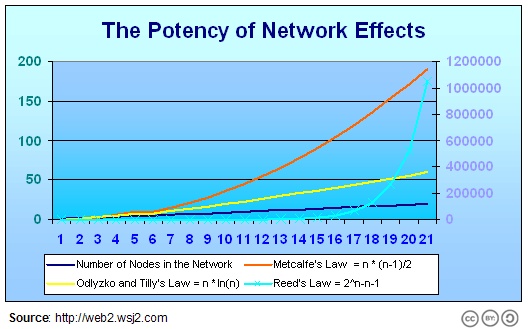A lot of the early descriptions of and speculation around Web 2.0 last year were either chock full of examples or long lists of interesting new phenomena that seemed to be emerging on the Web. My list of Web 2.0 explanations last year is a good survey of these. This year however we seem to be zeroing in on the core phenomena underlying the sea changes of the Web and even in society itself. Sure, some fundamental upgrades to the Web’s infrastructure – including steady and significant improvements to the physics of the Web – have also helped things along (i.e. those great Ajax/RIA applications we love so much like Gmail and Gliffy, download in seconds now.) But it’s the widespread use of the two-way Web that’s really the harbringer of an increasing sense of disruption.
Watch a TV panel that I was on with Google’s Adam Bosworth on how the improvements to the physics of the Internet have enabled Google’s newer products, particularly around SaaS and Ajax.
I wrote recently about the trend of Web 2.0 reductionism that is helping us get to Web 2.0 fundamentals and assisting us in understanding why it’s such a game changer. The upshot is that the Web is rapidly evolving and is increasingly being shaped by its users. If you’re not entirely sure that this is really a big deal though, you have only to look at the example of MySpace. MySpace is as pure a Web 2.0 play as you’re likely to find and they’ve exploited user generated content and network effects to become the #1 visited site on the Web (as of last week), from out of practically nowhere two years ago. This is an extremely impressive achievement and shows the power of Web 2.0 techniques to quickly best even the very largest and most established industry leaders, including Google and Yahoo! This demonstrates that the successful exploitation of what has been labelled “Web 2.0” can be an extremely disruptive force. People are sitting up and taking notice.

If only the keys to doing this were in everyone’s hands, the thinking goes, then disruption could be and would be widespread, even rampant, across business and society. And certainly, a lot of folks are very interested in taking advantage these techniques (such as maximizing your users’ social surface areas) both out on the Web, and within their own organizations. This further explains the interest by venture capital investors, startups, and enterprises to get into the game before others use these techniques first to upend the traditional industry leaders in their areas of interest. Mark my words, this year is only the beginning and those in less regulated industries that aren’t constrained from using Web-based network effects effectively are going to have a very tough time of it. This will prove to be true particularly in the next 24 months as everyone scrambles to try to figure out where this is all headed.
Fantastically and ironically, the keys to doing this actually are in everyone’s hands today, right now. Web 2.0 is a truly egalitarian force and though certain core competencies are required (being able to keep up with your own growth being one of them), just about anyone with a innovative idea and a good formulation of the techniques can access and tap into the existing audience of over 1 billion Web users.
Triggering Network Effects: As Simple As Establishing an Effective Viral Feedback Loop? Surprisingly, yes.
The Web is the fabric upon which an ever increasing amount of our lives is woven into. This is now most media including newspapers, TV, radio, entertainment, music, arts, etc. as well as what I call lifestyle logistics; e-mailing, IMs, calendaring, travel planning, time/task management, and more. They are all moving or have already moved to the Web. This very habit most of us have of being on the Web so much of the time, along with the easy lure of the hyperlink, which can redirect anyone via any of these ‘channels’ into a new Web 2.0 experience or site. Thus, if someone loves your new site, they send their friends the link, they send their friends, and so on. Instant pile-ons involving tens or hundreds of thousands of users overnight are now common. And good viral feedback loops keep them there and keep them coming back, and bringing their friends with them.
Of course, in a few years the exact design patterns for triggering a new MySpace, Facebook, or similar social juggernaut will become common. Then most likely balance will be reachieved in the industry and there will be less disruption. But for now the secret balance of Web 2.0 techniques that powers growth through efficient access to network effects is still an art (read my Notes on Making Good Social Software for an idea of how these design patterns might look however). The bottom line: the upside and downside potential of Web 2.0 is truly significant. And it means that in most industries doing nothing is really no longer an option.
But let’s talk about network effects for a minute. What are they? I’ve written before that the core description of a network effect is when a good or service has more value the more that other people have it too. Easy so far right? Examples include e-mail, IMing, the blogosphere, and even the Web itself. But what’s not clear from this description is the raw power that is caught up in and represented by network effects. Most rigorous studies and mathematical formulations reveal that there is tremendous geometric power in network effects. Though Robert Metcalfe originally coined Metcalfe’s Law to describe the raw potential of network effects in computer networks, most recent formulations have attempted to capture the exact value of them more precisely. Most notable has been David Reed with his relatively well-thought out and profound Reed’s Law, as well as Odlyzko and Tilly with their work. However, whichever formulation you believe is right (and Reed’s Law, if true, has staggering implications in this regard), the result is clear: At even an early point, the cumulative value of a large number of connected users goes exponentially off the charts.

The end result: If you have a million people visiting your Web site but you’re not leveraging network effects with them (such as by letting them contribute and letting others see and respond to those contributions), then you’re probably squandering the greater part of the value of that million person audience. Along comes someone else who does exploit the network effects of their users. They can quickly leapfrog you if they figure out a good way to establish and harness the connections between those same users, again in some kind of viral feedback loop. The new site will have the combined aggregated output of those users as part of its value proposition to new and existing users and it’s clear which will win. Examples: Digg bested Slashdot in just such a way. YouTube is set to do something very similar to network and cable television. Google is staging itself to best the #1 software company in the world. There are many others.
So what do you do? Most of us will soon face situations where the person or organization we’re competing against will be trying to use these same techniques to gain advantage, marketshare, or whatever. Agile development processes have taught us in recent years that that the tightest closed feedback loops resulted in better products, faster. The Web is now allowing feedback loops of this kind between staggering numbers of non-centrally coordinated people from a ready -to-tap worldwide audience. Emergent content, communities, and unintended results are all side effects of systems (and yes, your enterprise) with rampant network effects. Learning how to channel these feedback loops and the resulting network effects constructively will become a significant competitive advantage and a required core competency across the majority of professional disciplines in the very near future.
Read David Berlind’s excellent overview of Eventful and how they are using Web 2.0 techniques to be successful
But is this really happening? Is the competitive landscape about to be torn up? Are companies starting to respond? It does appear so. For one thing, I’m increasingly seeing traditional organizations trying to do things like “MySpacing” their current product offerings. Everything from Starwood Resorts to major national interest groups are looking at creating business communities that are really viral social networks powered by their users. It is a fascinating time to be building or reinventing a business. And if you haven’t started, now is probably the time to begin the effort. And worry not if you can’t figure it all out right now, the entire world is still trying to figure out how it applies to them too.
How will you apply Web 2.0 to your life, business, or organization?
